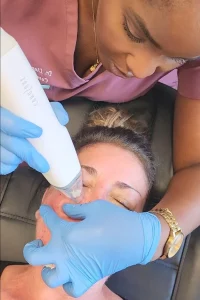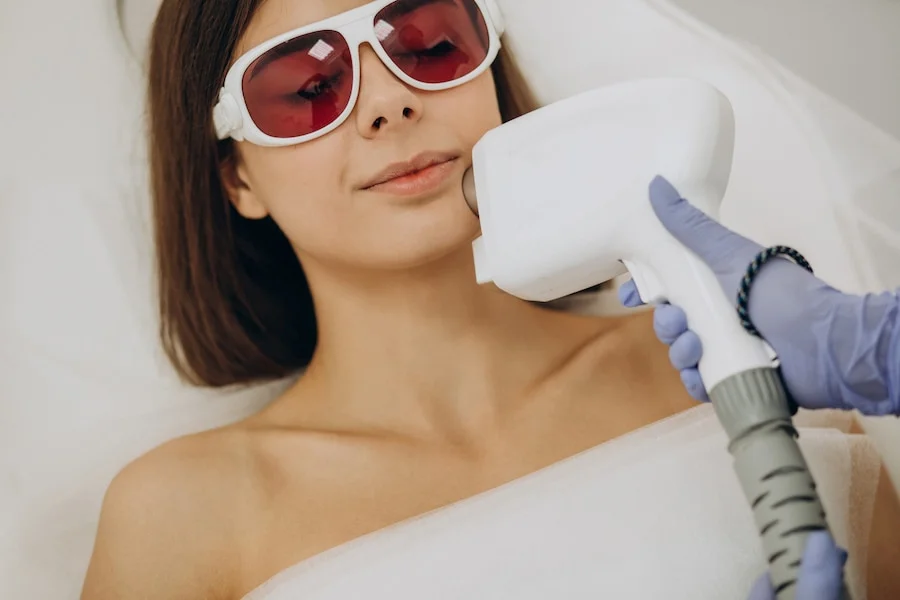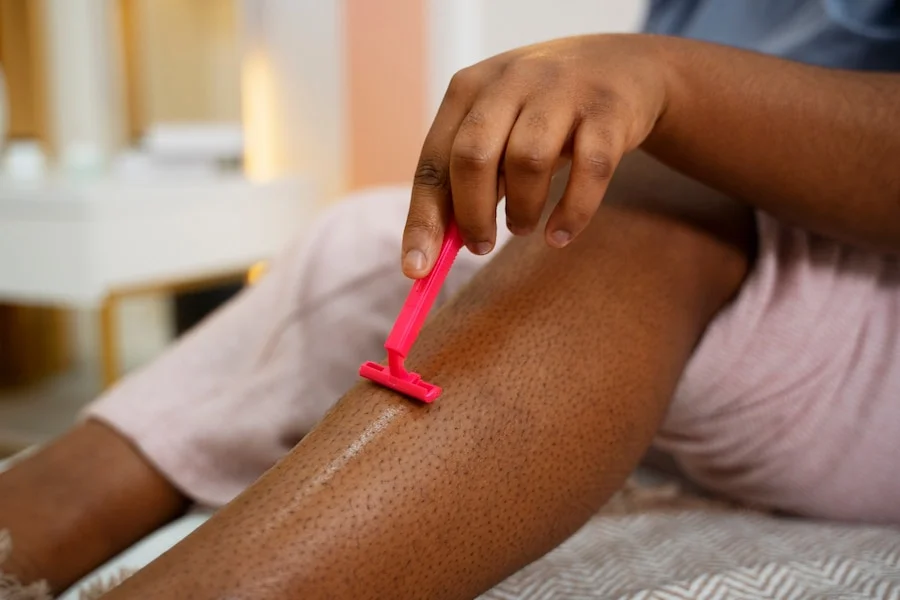Microneedling has become a popular choice for those seeking effective anti-aging treatments.
This procedure, known for its ability to stimulate collagen production, is often combined with Platelet-Rich Plasma (PRP) to enhance its benefits. This combination procedure is called PRP Microneedling.
In this comprehensive guide, we will explore the synergy between microneedling and PRP, its various applications, comparisons with other treatments, and essential considerations to help you make informed decisions about your skincare regimen.
Table of Contents
ToggleWhat is PRP Microneedling?
PRP microneedling is an advanced skincare treatment that combines traditional microneedling with PRP therapy.
Microneedling, or collagen induction therapy, involves the use of a needle roller or similar device to create micro-injuries in the skin.
This process stimulates the body’s natural collagen production, which helps to improve skin texture and appearance.
When PRP, a concentration of platelets derived from your own blood, is added, it can enhance the healing process and provide additional rejuvenating effects.
The PRP can be applied either topically or injected into the skin during the procedure.
How Does PRP Microneedling Work?
During a session, the skin is first numbed using a local anesthetic. The microneedling device then creates tiny punctures in the skin, which allows the PRP to penetrate more effectively.
PRP contains growth factors and proteins that further stimulate collagen and elastin production, accelerating the skin’s repair process and enhancing the overall results of microneedling.
Benefits of Platelet-Rich Plasma
Platelet-rich plasma, or PRP, is derived from your own blood.
During a PRP procedure, a small blood sample is taken and spun in a centrifuge to isolate the plasma, which is rich in platelets.
PRP is most potent when healing a wound, so when added to microneedling, it signals your body to kickstart the healing process. The benefits of PRP include:
- Reducing the appearance of acne scars
- Promoting better moisture retention
- Improving the appearance of wrinkles
- Treating rough skin texture and uneven complexion
- Providing ongoing improvements for weeks after treatment
- Minimising the risk of allergic reactions
- Softening stretch marks
- Reducing surgical scars
Benefits of PRP Microneedling for Skin, Hair, & Acne Scars
This combo-procedure offers numerous benefits, including improved skin texture, reduced fine lines and wrinkles, and enhanced skin tone.
It is particularly effective for treating acne scars, hyperpigmentation, and overall skin rejuvenation.
While commonly used on the face, this treatment can also be applied to other areas of the body for a more comprehensive approach to skincare.
Speak to a SkinCare Expert: Schedule A Potenza RF Microneedling Appointment Today! BOOK NOW
PRP microneedling is a fantastic treatment that blends the skin-revitalizing effects of microneedling with the healing power of platelet-rich plasma (PRP).
It’s important to remember that the results from this treatment aren’t immediate. Your body needs some time—usually a few weeks—to produce new collagen and rejuvenate the skin. So, you’ll continue to see improvements in the weeks after your session.
If you’re dealing with acne scars, microneedling with PRP can gradually improve your skin over several months, with noticeable changes often appearing within nine months.
In a 2016 study, researchers looked into the effects of adding PRP to microneedling for treating acne scars. The study involved 50 people with acne scars.
Those who had microneedling with distilled water saw about a 45.84% improvement in their scars. On the other hand, those who received microneedling combined with PRP experienced a greater improvement of 62.20%.
What’s reassuring is that none of the participants reported any lasting side effects from the treatment.
The same goes for treating stretch marks—results will keep getting better over time, although more prominent marks might need a few more sessions.
This treatment is also excellent for the delicate under-eye area, where it can enhance skin texture and reduce dark circles, giving you a more refreshed and youthful look.
Microneedling with PRP for Androgenetic Alopecia
When PRP microneedling is used on the scalp, those tiny micro-wounds created by the needles trigger your body’s natural healing process, which can lead to hair growth and thickening.
The PRP is applied directly into these micro-channels, boosting your body’s ability to heal and regenerate hair follicles.
A recent study aimed to compare the effectiveness of combining PRP with microneedling versus using PRP alone for treating androgenetic alopecia (AGA).
Conducted with 60 participants, the study found that adding microneedling to PRP treatment resulted in significantly better outcomes.
Those who received the combined treatment experienced a higher increase in hair count and greater improvements in hair loss compared to those who only had PRP.
Notably, there were no significant side effects reported with either treatment approach, highlighting the safety and efficacy of combining microneedling with PRP for addressing AGA.
Microneedling with PRP for Hyperpigmentation
Hyperpigmentation, or uneven skin tone, can result from factors like sun exposure or hormonal changes.
While traditional lightening creams may offer limited results, this microneedling combined procedure provides an effective alternative.
This non-invasive treatment combined with platelet-rich plasma (PRP), rich in healing growth factors, enhances skin rejuvenation and targets various types of discolouration, including:
Scar hyperpigmentation: Dark spots from acne scars or minor injuries.
Melasma: Hormone-induced dark patches.
Sunspots: Brown spots from UV exposure.
Results start appearing within a few weeks, offering a smoother, more even complexion.
PRP Microneedling vs. Regular Microneedling
Compared to regular microneedling, this combination procedure offers enhanced healing and reduced inflammation due to the additional application of PRP.
The combination can lead to faster recovery times and potentially better outcomes, especially for individuals with acne scars or significant skin damage.
Related: Is RF Microneedling Better Than Microneedling For Glowing Skin?
PRP Microneedling vs. RF Microneedling
Radiofrequency (RF) microneedling integrates radiofrequency energy with microneedling to promote deeper skin rejuvenation.
While both treatments stimulate collagen production, RF microneedling can target deeper layers of the skin. PRP microneedling, on the other hand, focuses on using the body’s natural healing properties to enhance results.
We’ll dive deeper into RF microneedling with PRP later in this article.
Enjoy the rejuvenating benefits of Potenza RF microneedling Fusion tips + PRP. Book An Appointment
PRP Microneedling vs. Chemical Peels
Chemical peels involve applying a chemical solution to exfoliate the skin and improve texture.
While effective, chemical peels can be more invasive and require longer recovery times. PRP microneedling, by contrast, promotes natural healing and often results in a shorter downtime.
PRP Microneedling vs. Laser Treatments
Laser treatments use focused light to target skin issues, such as pigmentation and wrinkles.
While laser treatments can be effective, PRP microneedling offers a more natural approach by using your own blood components to stimulate healing.
The choice between the two depends on individual skin concerns and desired outcomes.
Microneedling & PRP Aftercare Instructions
- For the first 72 Hours, avoid using aggressive skincare products and always wear sunscreen with at least SPF 30 when outdoors.
- Immediately after treatment your provider may apply a moisturizer and sunscreen. Refrain from taking anti-inflammatory medications like ibuprofen, Motrin, or Advil, as they can interfere with the natural inflammatory process essential for skin rejuvenation.
- Stay out of the sun as much as possible. If you need to be outdoors, make sure to use SPF 30 or higher and reapply as needed. A gentle cleanser can be used before bed.
- Redness and Sensitivity are common and may last a few days. Use Tylenol if needed for soreness.
- Use a clean pillowcase for three nights post-procedure and ensure that anything touching your face, like makeup brushes or glasses, is clean.
- Eating fresh pineapple may help optimize healing. Avoid strenuous exercise and sweating for 24 hours to prevent irritation from open pores.
- Avoid sun exposure for at least three days, ideally up to ten. Apply SPF 30 or more every two hours if outside.
- Mineral makeup can be applied after 24 hours. Regular skincare routines can be resumed after 48 hours, but hold off on using Retin-A until 72 hours post-treatment.
- For best results, a series of 3–5 treatments spaced four weeks apart is recommended.
Cynosure’s B.E. Beautiful Energy skincare: the new standard of care for laser and energy-based treatments
How Long Does the Results Last?
The results don’t happen overnight, but they’re worth the wait. As your body gradually builds collagen, you’ll start noticing improvements in your skin’s texture and appearance, including reductions in acne scars and wrinkles.
These changes typically continue to develop over several months, with the rejuvenating effects lasting up to a year after the initial series of treatments.
While PRP microneedling may not offer a permanent solution for facial rejuvenation, it does provide long-term improvements, especially in the appearance of acne scars.
Microneedling with PRP Cost In Canada
The cost of PRP microneedling can vary based on your location in Canada, provider, and your specific needs.
Factors influencing cost include the number of sessions required and the area being treated.
At Dr. Lian Beauty in Limoges, Ontario, we offer Potenza RF microneedling with Fushion Tip + PRP at $400 CAD as an add-on treatment per session.
See also: Potenza RF Microneedling Treatment Full Price List

PRP microneedling is generally more expensive than regular microneedling but may offer additional benefits that justify the higher cost.
When comparing costs with other treatments like laser therapies or chemical peels, consider the potential benefits and outcomes specific to your skin concerns.
Who Should Avoid PRP Microneedling?
Microneedling with PRP might not be suitable for everyone. If you’re pregnant or have certain conditions, it’s best to check with your doctor before proceeding. Specifically, you should be cautious if you:
- Have used or are currently using isotretinoin for acne
- Have active acne
- Struggle with skin conditions like eczema, psoriasis, or rosacea.
- Have a history of scarring or bruising easily
- Have a platelet or blood disorder
- Have had major surgery in the past 6 months
- Have HIV
- Have a chronic illness
- Have an active facial infection, such as herpes
If you fall into any of these categories, make sure to talk to your healthcare provider to ensure that microneedling with PRP is safe for you.
Radiofrequency Microneedling with Platelet-Rich Plasma
While microneedling is effective on its own, combining it with radiofrequency and PRP takes the results to the next level.
This combination not only addresses issues like sun damage but also promotes skin tightening, reduces acne scars, and offers even more noticeable improvements.
What is Potenza RF Microneedling: The Secret To Flawless Skin
Benefits of Radiofrequency
Radiofrequency is essentially a low-level electromagnetic current that creates controlled damage to the skin.
It’s not strong enough to shock your body but can penetrate deeper than microneedles alone, allowing for more extensive skin repair. The benefits of adding radiofrequency to microneedling include:
- Promoting skin tightening
- Improving skin elasticity
- Firming facial tissues
- Reducing fine lines and wrinkles
- Boosting collagen, elastin, and hyaluronic acid production
- Treating deeper layers of skin
- Preventing and treating sun damage
- Creating a smoother skin texture
- Offering longer-lasting results than traditional skincare treatments
- Improving skin tone
- Ensuring safety for all skin types
Frequently Asked Questions
Is RF Microneedling with PRP Safe for All Skin Types and Tones?
Yes it is. Since radiofrequency isn’t a laser and no harsh chemicals are applied, RF microneedling with PRP is safe for all skin types and tones.
If you have sensitive skin, your esthetician or medical aesthetician can adjust the settings to ensure the treatment is gentle and effective.
What Are the Risks of RF Microneedling with PRP?
RF microneedling with PRP has minimal risks, and any complications that do arise are typically temporary and treatable. Your medical aesthetician will assess your individual risks during the consultation. Rare complications include:
- Inflammation
- Infection
- Prolonged or severe side effects
- Acne flare-ups
- Dry skin
- Headaches
- Cold sore flare-ups
Most of these risks can be managed with proper care before and after treatment, and by choosing a qualified provider. Long-term complications are very rare.
How Does Platelet-Rich Plasma Work?
When your body detects platelet-rich plasma in the treatment area, it assumes there’s a wound that needs healing.
This triggers the body’s natural repair processes, which help reduce wrinkles, acne scars, and sun damage, making PRP a powerful tool for skin rejuvenation and collagen production.
What Is Radiofrequency?
Radiofrequency uses a low-level electrical current, combined with heat and sound waves, to tighten and create controlled damage to the skin.
This stimulates a healing process that can reach deeper skin layers than microneedling with PRP alone.
How Often Can I Get RF Microneedling with PRP?
Typically, you’ll start with one session every two to four months. After completing your initial treatments, your esthetician may recommend maintenance sessions once or twice a year.
You can also combine microneedling with other aesthetic treatments as part of your skincare routine.
Conditions Treated with RF Microneedling with PRP
RF microneedling is ideal for treating various skin conditions. Your provider or medical aesthetician will recommend the best treatments based on your skin quality, medical history, and the extent of the damage. Conditions that can be treated with RF microneedling and PRP include:
- Acne scars
- Stretch marks
- Fine lines and wrinkles
- Large pores
- Cystic acne
- Redness
- Inflammation (depending on the cause)
- Hyperpigmentation
- Rough skin texture
- Uneven skin tone
Your medical aesthetician may also suggest additional treatments, like chemical peels, oxygen facials, or under-eye PRP injections, to further enhance your results.
Conclusion
In conclusion, PRP microneedling is a highly effective treatment that taps into your body’s natural healing abilities to rejuvenate the skin, smooth out scars, and enhance overall skin texture.
For even greater results, consider combining it with RF microneedling, which we offer at Dr. Lian Beauty using our Potenza RF microneedling Fusion Tip.
This advanced treatment goes deeper to deliver more noticeable improvements.
If you have any questions or want to explore how PRP RF microneedling can work for you, feel free to contact us or book your appointment today. We’re here to help you achieve glowing, healthy skin!
Enjoy the Rejuvenating Benefits of RF Microneedling near You:

Dr. Lian Peter, MD, MPH, CCFP, is a Family physician with a passion for aesthetics. In her aesthetic clinic, she provides a wide range of minimally invasive and non-invasive procedures, constantly honing her skills to deliver exceptional care and help patients attain their desired appearance.






